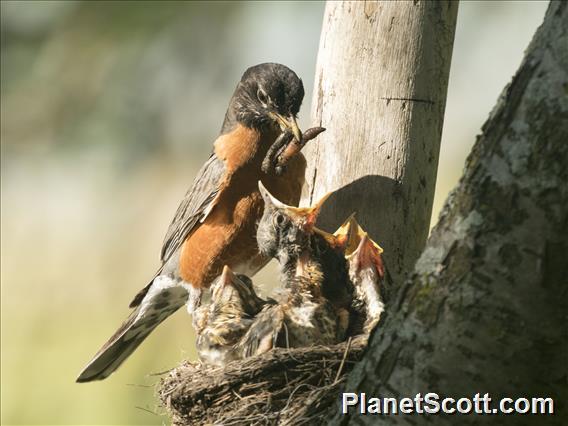American Robin (Turdus migratorius)

American Robin (Turdus migratorius)

American Robin (Turdus migratorius)

American Robin (Turdus migratorius)

American Robin (Turdus migratorius)




×





American Robin (Turdus migratorius)

American Robin (Turdus migratorius)

American Robin (Turdus migratorius)

American Robin (Turdus migratorius)
About American Robin (Turdus migratorius)
- Kingdom: Animals
- Phylum: Chordates
- Class: Birds
- Order: Perching Birds
- Family: Thrushes and Allies
The American robin is a migratory bird of the true thrush genus and Turdidae, the wider thrush family. It is named after the European robin because of its reddish-orange breast, though the two species are not closely related, with the European robin belonging to the Old World flycatcher family. The American robin is widely distributed throughout North America, wintering from southern Canada to central Mexico and along the Pacific coast.
Source: Wikipedia
Trips
Visits
-
1983-06-06
Elgin, United States of America -
1995-06-15
Mission - My Backyard, United States of America -
-
2002-06-15
Volcan Nevada de Colima, Mexico -
2006-02-14
Bernal Hill, United States of America -
2006-06-06
McLaren Park, United States of America -
2007-01-05
Bernal Hill, United States of America -
2007-06-14
Cape May Point State Park, United States of America -
2008-05-29
Presidio - El Polin Spring, United States of America -
2008-07-10
Shea Stadium, United States of America -
2008-12-22
Bernal Hill, United States of America -
2009-04-04
Glen Canyon Park, United States of America -
2009-05-05
Elgin - Bluff Spring Fen, United States of America -
2009-05-08
Burnidge Forest Preserve, United States of America -
2009-06-10
Glen Canyon Park, United States of America -
2009-11-22
Palo Alto Baylands, United States of America -
2010-02-16
El Rosario, Mexico -
2010-02-19
Volcan Nevado de Toluca, Mexico -
2010-04-18
Point Reyes National Seashore, United States of America -
2010-06-08
Talkeetna, United States of America -
2010-06-08
Denali State Park, United States of America -
2010-10-30
Miller Meadow Forest Preserve, United States of America -
2011-05-28
Del Valle County Park, United States of America -
2011-10-08
Crabtree Nature Center, United States of America -
2012-06-01
Higgins Lake, United States of America -
-
2012-06-13
Mount Davidson, United States of America -
2012-07-08
Necedah NWR, United States of America -
2012-07-08
Elgin, United States of America -
2012-07-09
Sax-Zim Bog, United States of America -
-
2012-07-12
Yellowstone National Park, United States of America -
2012-07-13
Grand Teton National Park, United States of America -
2012-09-19
Golden Gate Park - North Lake, United States of America -
2012-09-22
East Wash, United States of America -
2013-03-04
John Heinz NWR at Tinicum (IBA), United States of America -
2013-03-24
Fort Mason, United States of America -
2013-05-06
Mount Davidson, United States of America -
2013-06-05
Lake Tabeaud, United States of America -
2013-07-02
Yolla Bolla Wilderness, United States of America -
2013-09-07
Mountain Lake, United States of America -
2013-09-08
Bernal Hill, United States of America -
2013-09-28
Presidio - El Polin Spring, United States of America -
2013-12-07
Golden Gate Park - San Francisco Botanical Garden, United States of America -
2014-02-16
Golden Gate Park - San Francisco Botanical Garden, United States of America -
2014-02-20
Mission - My New Backyard, United States of America -
2014-03-01
Fort Mason, United States of America -
2014-03-08
Tule Elk State Reserve, United States of America -
2014-03-10
San Simeon SP, United States of America -
2014-03-15
Alemany Community Garden, United States of America -
-
2014-04-26
Bernal Hill, United States of America -
2014-05-03
Glen Canyon Park, United States of America -
2014-05-09
Cave Creek Canyon--Southwestern Research Station, United States of America -
2014-05-10
Pinery Canyon, United States of America -
2014-05-10
Cave Creek Canyon--South Fork, United States of America -
2014-05-11
Miller Canyon, United States of America -
2014-06-07
Sunol Regional Wilderness--Visitor Center area, United States of America -
2014-06-15
Golden Gate Park - North Lake, United States of America -
2014-07-16
Nome, United States of America -
2014-07-17
Nome--Safety Sound, United States of America -
2014-07-18
Nome-Kougarok Road, United States of America -
2014-07-19
Nome-Teller Hwy, United States of America -
2014-07-21
Kenai Peninsula, United States of America -
2014-07-21
Seward, United States of America -
2014-09-20
East Wash, United States of America -
2014-09-27
Mount Davidson, United States of America -
2014-10-02
Golden Gate Park - San Francisco Botanical Garden, United States of America -
2014-11-29
Lafayette Park, United States of America -
2014-12-08
Golden Gate Park - San Francisco Botanical Garden, United States of America -
2014-12-27
Heron's Head Park, United States of America -
2014-12-28
Glen Canyon Park, United States of America -
2015-01-01
Candlestick Park, United States of America -
2015-01-14
Bernal Hill, United States of America -
2015-01-17
Lafayette Park, United States of America -
2015-01-18
Tilden Regional Park, United States of America -
2015-01-19
Lake Merced , United States of America -
2015-01-20
Arrowhead Marsh, United States of America -
2015-01-21
Shollenberger Park, United States of America -
-
-
-
-
-
-
-
-
-
-
-
-
-
-
-
-
-
-
-
-
-
-
-
-
-
-
-
-
-
-
-
-
-
-
-
-
-
-
-
-
-
-
-
-
-
-
-
-
-
-
-
-
-
-
-
-
-
-
-
-
-
-
-
-
-
-
-
-
-
-
-
-
-
-
-
-
-
-
-
-
-
-
-
-
-
-
-
-
-
-
-
-
-
-
-
-
-
-
-
-
-
-
-
-
-
-
-
-
-
-
-
-
-
-
-
-









